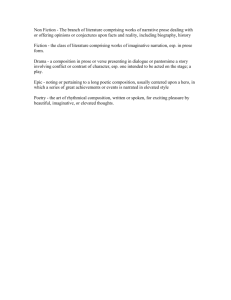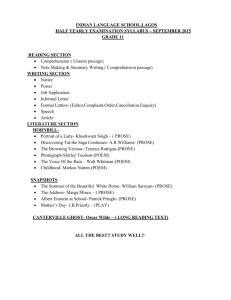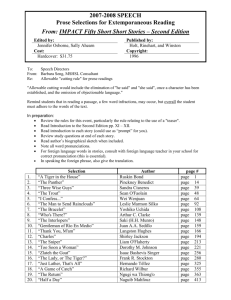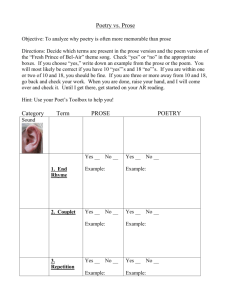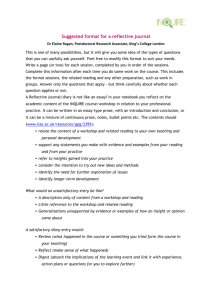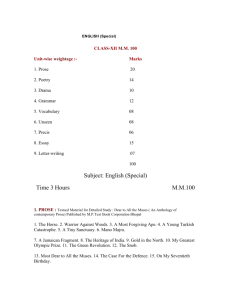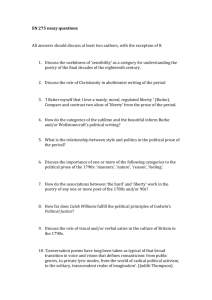Group Activity 2: Understanding Prose Type
advertisement
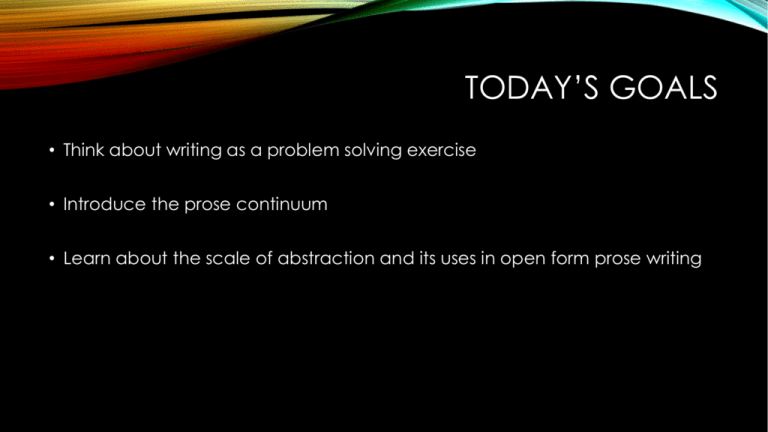
TODAY’S GOALS • Think about writing as a problem solving exercise • Introduce the prose continuum • Learn about the scale of abstraction and its uses in open form prose writing BRAINSTORM ACTIVITY • Spend 1 minute brainstorming and reflecting on the following: • Think about some of your favorite television shows, movies, or book series • What makes them so compelling or interesting? • How is the majority of the tension created? • What are the main characters trying to accomplish GROUP ACTIVITY 1: FINDING A PROBLEM • In your unit 1 groups • Select 5 or more pieces of fiction. Novels, movies, comics, and *sometimes* television shows can be acceptable for this. • If your group is at a loss for common ground, you may use sample essays from the textbook • For each piece of fiction, identify the main problem that is being addressed in the work. Furthermore, identify how that problem was solved. • You should produce a coherent sentence or two for each piece of fiction • Please use examples we have not already discussed in class GROUP ACTIVITY 2: UNDERSTANDING PROSE TYPE • In your unit 1 groups • Review “A Letter to the Editor” on pg. 6 and “A Festival of Rain” on pg. 7 • Answer questions on pg 8 • Note: Each group should turn in one sheet of paper with all the group members’ names and answers NEW VOCABULARY • Prose Continuum • Closed Form Prose • Open Form Prose NEW VOCABULARY • Thesis Question • Thesis Statement • Theme • How do these three vocabulary items relate to one another? How do they relate to viewing writing as problem solving? AFTER THE BREAK • Read A&B p.71-74 (Starting with “Use specific details […]” • Read 487-490 (Starting with “Write low […]”) OPEN FORM PROSE • Examples: Novels, poems, short stories, some articles, literacy narratives, exploratory and free writing, journal entries, etc • Important characteristics: • • • • Organized around a theme or plot rather than a thesis Has characters and settings that are vividly described Uses concrete language and figurative language to portray or evoke emotions. Dialogue may also be used to provide further emotion and information NEW VOCABULARY • Scale of Abstraction • Concrete Words • Abstract Words GROUP ACTIVITY 3: CONTRASTING DESCRIPTIONS • In your unit 1 groups • Select a setting that everyone in the group is familiar with. Suggestions include: the beach, a mall, a particular place at FIU, the park, etc. Be specific here. • Produce a 1 paragraph description of the setting that extensively uses concrete words. Then, produce a 1 paragraph description that heavily uses concrete words and conveys something important about the setting. • The whole group should work on both descriptions rather than dividing them up VOCABULARY THUS FAR • Rhetoric • Rhetorical Context • • • Purpose Audience Genre • Prose Continuum • • Closed Form Prose Open Form Prose • Scale of Abstraction • • Concrete Words Abstract Words • Thesis Question • Thesis Statement • Theme Note: these are the types of items that I might ask you about on a possible future quiz HOMEWORK: • Find Example Open Form Prose: • Bring in a sample of open form prose that interests you. • You should bring in at least one page of writing with concrete language and/or figurative language. • Be prepared to use this in class on Friday. • Finish reading chapter 1 • Minor Essay 1 • Follow the “Brief Writing Project 1” prompt on p 23. • This should be a typed, two-page, double spaced, MLA format document. • Due Monday 6/29
